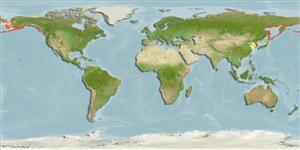Environment: milieu / climate zone / depth range / distribution range
Ecología
marino demersal; rango de profundidad 0 - 60 m (Ref. 50550). Temperate
North Pacific: off the Okhotsk coast of Hokkaido to the northern Sea of Japan and the Bering Sea.
Tamaño / Peso / Age
Maturity: Lm ? range ? - ? cm
Max length : 13.0 cm TL macho / no sexado; (Ref. 56557)
Short description
Morfología | Morfometría
Espinas dorsales (total): 7 - 9; Radios blandos dorsales (total): 12-14; Espinas anales 0; Radios blandos anales: 10 - 12. Four preopercular spines, the uppermost curved upward (Ref. 559). Supraocular cirrus simple (Ref. 559). Pelvic fin united with belly by means of a wide dermal fold (Ref. 559).
Common in the littoral zone at depths up to 30 m. Probably spawns in the littoral zone and its larvae and fry are transported to river estuaries in tides (Ref. 26949).
Life cycle and mating behavior
Madurez | Reproducción | Puesta | Huevos | Fecundidad | Larva
Robins, C.R., R.M. Bailey, C.E. Bond, J.R. Brooker, E.A. Lachner, R.N. Lea and W.B. Scott, 1991. Common and scientific names of fishes from the United States and Canada. Am. Fish. Soc. Spec. Publ. (20):183 p. (Ref. 3814)
IUCN Red List Status (Ref. 130435)
Threat to humans
Harmless
Human uses
Más información
Nombres comunesSinónimosMetabolismoDespredadoresEcotoxicologíaReproducciónMadurezPuestaAgregación para la puestaFecundidadHuevosEgg development
Age/SizeCrecimientoLength-weightLength-lengthLength-frequenciesMorfometríaMorfologíaLarvaDinámica larvariaReclutamientoAbundanciaBRUVS
ReferenciasAcuiculturaPerfil de acuiculturaRazasGenéticaElectrophoresesheritabilidadEnfermedadesProcesamientoNutrientsMass conversion
ColaboradoresImágenesStamps, Coins Misc.SonidosCiguateraVelocidadTipo de nataciónSuperficie branquialOtolitosCerebrosVisión
Herramientas
Special reports
Download XML
Fuentes de Internet
Estimates based on models
Preferred temperature (Ref.
123201): 1 - 7.1, mean 2.9 °C (based on 414 cells).
Phylogenetic diversity index (Ref.
82804): PD
50 = 0.7500 [Uniqueness, from 0.5 = low to 2.0 = high].
Bayesian length-weight: a=0.01000 (0.00244 - 0.04107), b=3.04 (2.81 - 3.27), in cm total length, based on all LWR estimates for this body shape (Ref.
93245).
Nivel trófico (Ref.
69278): 3.5 ±0.53 se; based on food items.
Resiliencia (Ref.
120179): Medio, población duplicada en un tiempo mínimo de 1.4-4.4 años (Preliminary K or Fecundity.).
Fishing Vulnerability (Ref.
59153): Low vulnerability (10 of 100).
Nutrients (Ref.
124155): Calcium = 111 [43, 252] mg/100g; Iron = 0.42 [0.19, 0.96] mg/100g; Protein = 17.3 [15.0, 19.5] %; Omega3 = 0.638 [0.254, 1.788] g/100g; Selenium = 9.96 [4.19, 25.33] μg/100g; VitaminA = 32.2 [8.6, 110.7] μg/100g; Zinc = 0.866 [0.547, 1.514] mg/100g (wet weight);
